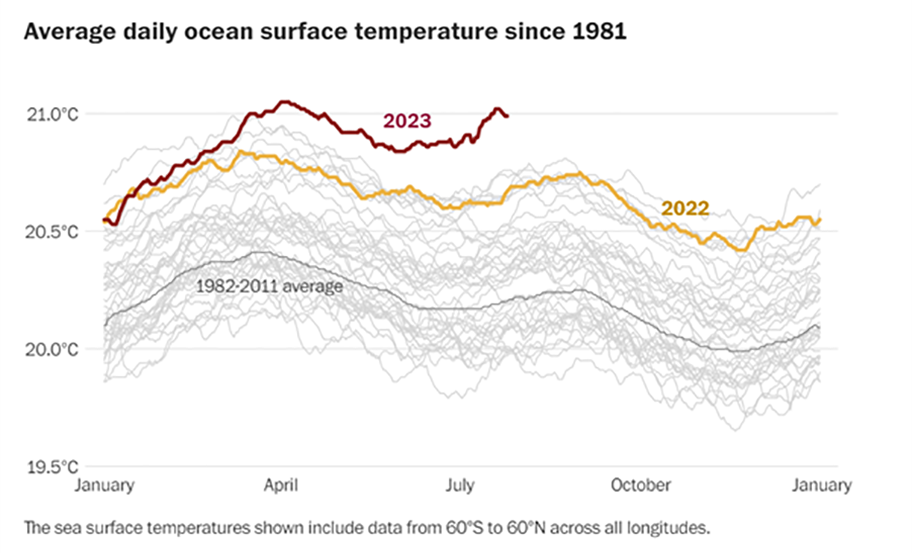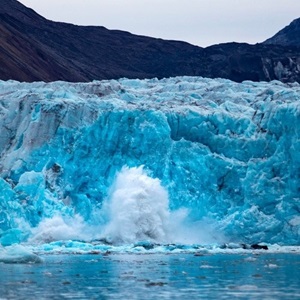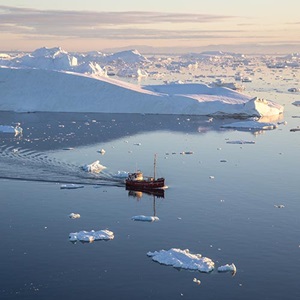By Will Little
What are marine heatwaves?
Marine heatwaves are rises in ocean temperature that are above the average for the time of year and last for an extended period of time. The US’s National Oceanic and Atmospheric Administration (NOAA) defines this as water temperatures being “warmer than 90% of the previous observations for a given time of year.” Heatwaves can last for weeks, months or even years and have adverse effects on marine life including fish stocks.
While marine heatwaves are rapid increases in sea temperature often caused by changes in local wind patterns, the gradual warming of the seas that has developed over many years is caused by oceans absorbing the extra heat caused by global warming.
Once a marine heatwave is identified by the NOAA Marine Heat Watch service, it is categorised based on its intensity from 1 (moderate) to 5 (beyond extreme).
However, marine heatwaves are becoming hotter by a ‘very large margin’, according to the EU’s Copernicus Climate Change Service. The organisation said that the global ocean sea surface temperatures in June 2023 were higher than any previous June on record.
The first week of August in 2023 also saw the average daily global sea surface temperature beat a 2016 record, reaching 20.96C (69.73F).
What causes marine heatwaves?
Wind speeds play a crucial role in regulating the temperature of the oceans. They churn up the sea, encouraging the mixing of cooler deep water with the warmer water at the surface. This is less likely to occur if wind speeds drop or disappear altogether.
The most well-known cause of marine heatwaves is El Niño (or the El Niño Southern Oscillation), a global weather phenomenon where wind speeds slow or disappear altogether, driving up sea temperatures.
90%
20.96°C
US$800M
3 years
Climate change, however, is accelerating and causing hotter marine heatwaves to develop. According to the Intergovernmental Panel on Climate Change (IPCC), 90% of the extra heat generated from global warming has been absorbed by the oceans. As a result, any naturally occurring marine heatwaves will now be more severe as the global average sea temperature continues to increase.
Climate change is also increasing the frequency of atmospheric conditions that slow winds down, making marine heatwaves more common and driving ocean temperatures even higher.
The 2023 North East Atlantic marine heatwave was partly caused by changes in wind circulation as a result of climate change. According to the EU’s Copernicus Climate Change Service, the Azores High, an area of high air pressure over the Atlantic Ocean, was much weaker than average in June 2023. This resulted in wind speeds dropping by the largest amount since records began. The lower wind speeds prevented surface water mixing with the cooler water below, allowing sea surface temperatures to increase.

What is the impact of marine heatwaves on fisheries?
Marine heatwaves can cause significant disruption to fisheries, the abundance and health of fish stocks and ultimately what fisheries catch.
Sometimes decisions must be taken quickly to ensure the sustainability of a population. For instance, the El Niño phenomenon caused the world’s largest pelagic fishery, the Peruvian Anchoveta fishery, to cancel its 2023 fishing season.
The 2014-2016 US West Coast marine and 2011 Western Australia heatwaves reduced fish populations to such an extent that fisheries closed for more than three years to help rebuild fish stocks.
The marine heatwave in the Gulf of Alaska in 2013 had a devastating impact on the marine ecosystem. The cod population dropped by 100 million fish as the heat restricted Pacific cod spawning habitats. In 2020, as the population struggled to recover, the government closed the commercial season for the first time in its history to help stocks recover.
A recent study found that the socio-economic costs of a single marine heatwave event were huge, exceeding US$800 million in direct losses or US$3.1 billion in indirect losses of ecosystem services for multiple years.
How frequent are marine heatwaves?
Marine heatwaves are not only becoming more frequent but also more widespread and more severe. A 2021 report by the Intergovernmental Panel on Climate Change (IPCC) found marine heatwaves doubled in frequency between 1982 and 2016, and have become both more intense and longer since the 1980s.
Of the 2023 marine heatwaves in the North Atlantic, for instance, NOAA’s Marine Heatwave Watch classified West of Ireland up to a Category 5 (‘Beyond Extreme’), with sea surface temperatures as high as 4-5°C above average. Waters around the UK and the Baltic Sea reached Category 4 (‘extreme’) marine heatwave. These classifications are usually only seen in the tropics and are the highest since records began.

Where are marine heatwaves happening?
Marine heatwaves are occurring globally. Extreme marine temperatures hit the coasts of Ireland and the UK, and in the Baltic Sea in June 2023.
NOAA has observed a large offshore heatwave in the Gulf of Alaska since 2022 and has been monitoring an ongoing large marine heatwave off the west coast of the US and Canada since May 2023. The 2023 marine heatwave off the coast of southern Florida is the hottest on record.
Also In mid-2023, marine heatwaves were recorded near New Zealand and Australia as well as in the Labrador Sea, south of Greenland.
At the same time, the Mediterranean Sea is also experiencing extreme water temperatures reaching a high of more than 30C in the Gulf of Taranto, smashing all previous records. Sea temperatures in southern Spain and North Africa were 5 degrees centigrade hotter than the average for the time of year.
What is the impact of marine heatwaves on marine ecosystems?
The full impact of 2023’s marine heatwaves won’t be known for a while. However, we know there are both short-term and long-term effects of marine heatwaves, which are different to the impact of more gradual warming from climate change.
North East Atlantic pelagic fish, such as mackerel, Atlanto-Scandian herring and blue whiting, for instance, have already been impacted by the gradual warming of the seas from climate change. Over a number of years these stocks have been pushed farther north and east in search of cooler waters.
However, marine heatwaves are more likely to reduce their ability to spawn. Research has found that warming seas, including marine heatwaves, have affected some Atlanto-Scandian herring populations by 40% between 2005 and 2015.
Fish that prefer cold water, like cod and salmon, are particularly vulnerable to heatwaves. Warm water forces them to work harder, which means they need more food to sustain themselves. At the same time, it can make prey less accessible. For example,
marine heatwaves can prevent the zooplankton salmon feed on from rising to the surface, removing what would otherwise be an easy meal. Cod also feed on tiny shrimp-like creatures called copepods, and the changing temperature can mean the copepods
breed at the wrong time for the cod larvae to feed on, which result in fewer cod the following year.
There is well documented evidence of the impact of previous marine heatwaves around the world. The 2011 Western Australia marine heatwave resulted in high fish mortality rates and deaths of kelp forests,
while 2016’s caused the worst coral bleaching ever seen on the Great Barrier Reef.
Australia’s Abrolhos Island’s scallop fishery also had to close for a fishing season to help stocks recover after the 2021 marine heatwave stopped the scallops from spawning, devastating the population.
In the Mediterranean
Sea, high water temperatures between 2015-19 led to reoccurring large scale deaths of key species such as corals and seaweed.
The most direct and dramatic impact of marine heatwaves is the triggering of mass mortality. Non-mobile organisms, like coral, algae and sponges, that cannot escape the extreme environmental conditions, are particularly prone to extreme thermal stress.
Witness to Climate Change: Abrolhos Island and mid-west scallop trawl fishery
How can sustainable fishing provide resilience against marine heatwaves?
While not immune to the impacts of marine heatwaves and climate change, sustainable fisheries are better prepared to respond to the extremes that climate change brings.
Many of the key components of sustainable fisheries management set fisheries up to be more adaptable to change. These include:
- Following scientific advice on fisheries management, including the consideration of current stock health. This ensures more healthier and more resilient fish stocks
- More frequent and comprehensive levels of monitoring of target fish and bycatch populations and their distribution, as well as environmental indicators. This means that fisheries managers can detect and respond to changes and secure catches that meet sustainable standards.
- Responsive management systems, including harvest strategies that allow fisheries to reduce catches to pre-agreed levels if stocks start to decline. This means that fisheries managers can react to changing conditions, ensuring the fishery remains sustainable.




